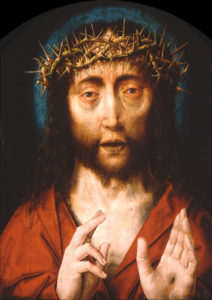Object of the Month: April 2014
The Man of Sorrows
Oil on panel
Albrecht Bouts
Flemish, c. 1452-d. 1549
Albrecht Bouts was born into an artistic family; his father, Dieric, was one of the most prominent artists in Louvain in the mid-fifteenth century and was elected official painter to the city in 1468. Albrecht learned his craft working closely with his father in his workshop; Dieric’s influence on his son’s artistic technique is seen most in Albrecht’s compositional choices rather than his style and brushwork. The present devotional panel, The Man of Sorrows, is widely believed to be based on a lost type created by Dieric; Albrecht would have been familiar with such images in his father’s shop as well as had access to his cartoons and drawings. Small and intimately composed images of Christ and Mary became enormously popular in the last part of the fifteenth century and into the sixteenth century, largely emanating from the workshops of the father and son.
The close-up focus on Christ’s face in this composition is a variation of an earlier fifteenth century model and reflects the Netherlandish trend of pious adoration of Christ’s head. Here, the bust-length image of Christ is presented frontally with a gaze fully engaging the viewer. Christ’s sunken, blood-shot eyes confront and invite the devotee to deeply contemplate the evidences of His suffering for mankind’s behalf. His eyelids are nearly half-way down, reflecting the countless hours of agony, pain, torture and sleeplessness. His brow bears a thick, entwined crown of thorns—one of the primary emblems of Christ’s torment and shame. Unlike any contemporary Italian painter’s conception of this theme, Bouts fully renders each thorn to depict their excruciating effect. On Christ’s sullen cheeks, translucent tears echo the flow of blood; the cool purple color of Christ’s lips reflect the blood loss and strain of torment. Finally, both Christ’s hands are raised in a blessing gesture.
Though many variations of this bust-length subject exist from Bouts and his workshop, very few, if any, are exactly alike. However, such detailed, realistic imagery focused on Christ’s substitutional sacrifice reflects the contemporary interest to contemplate Christ’s head and wounds both in art, but also in devotional tracts and meditations such as Thomas à Kempis’s Imitation of Christ.
Published in 2014
